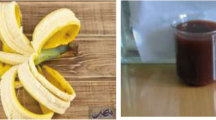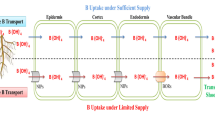Abstract
Imidacloprid (IMI) is a commonly used pesticide against aphids and accumulates in plant parts, maximum in leaves. Present study was conducted to check the efficiency of seed pre-soaking with 24-epibrassinolide (24-EBL) for reduction of this pesticide in the leaves of Brassica juncea L. plants raised from 24-EBL pre-soaked seeds and grown in soils supplemented with IMI. Leaves were analyzed for IMI residues using gas chromatography-mass spectrometry (GC-MS). Activities of guaiacol peroxidase (POD), glutathione reductase (GR), and glutathione S-transferase (GST), and glutathione (GSH) content were determined by spectrophotometry. Soil containing 350 mg IMI/kilogram soil resulted in 88.66 μg/g fresh weight (FW) of IMI residue in the leaves, which was maximum decrease to 35.31 μg/g FW (60.17 %), when seeds were pre-soaked in 100 nM 24-EBL. In this treatment (350 mg IMI/kilogram soil + 100 nM 24-EBL), GSH content, GR, POD, and GST activities were increased by 42.30, 34.5, 20.5, and 13.4 %, respectively, as compared to plants grown in soils amended with 350 mg IMI/kilogram soil.



Similar content being viewed by others
Abbreviations
- 24-EBL:
-
24-Epibrassinolide
- ANN:
-
Artificial neural network
- AOAC:
-
Association of Official Agricultural Chemists
- BRs:
-
Brassinosteroids
- CBZ:
-
Carbendazim
- cDNB:
-
Chloro-dinitrobenzene
- CHT:
-
Chlorothalonil
- CMT:
-
Cypermethrin
- CPF:
-
Chlorpyrifos
- DTNB:
-
Dithionitrobenzoic acid
- EDTA:
-
Ethylenediaminetetraacetic acid
- FW:
-
Fresh weight
- GC-MS:
-
Gas chromatography-mass spectrometry
- GR:
-
Glutathione reductase
- GSH:
-
Glutathione
- GST:
-
Glutathione S-transferase
- IMI:
-
Imidacloprid
- LC-MS:
-
Liquid chromatography-mass spectrometry
- MLR:
-
Multiple linear regression
- MRP:
-
Multidrug resistance-associated protein
- NADPH:
-
Nicotinamide adenine dinucleotide phosphate
- POD:
-
Guaiacol peroxidase
- PSA:
-
Primary secondary amine
- QuEChERS:
-
Quick, easy, cheap, effective, rugged, and safe
- RBOH1:
-
Respiratory burst oxidase homologue 1
- ROS:
-
Reactive oxygen species
- UGT:
-
UDP-glycosyltransferase
- UN:
-
United Nations
References
Alsayeda H, Pascal-Lorber S, Nallanthigal C, Debrauwer L, Laurent F (2008) Transfer of the insecticide [14C] imidacloprid from soil to tomato plants. Environ Chem Lett 6:229–234
AOAC (Association of Official Analytical Chemists) (2007) Pesticide residues in foods by acetonitrile extraction and partitioning with magnesium sulfate, gas chromatography/mass spectrometry and liquid chromatography/tandem mass spectrometry first action 2007. Official method 01. 2007. AOAC International, Maryland
Bhardwaj R, Sharma P, Arora HK, Arora N (2008) 28-Homobrassinolide regulated mn-uptake and growth of Brassica juncea L. Can J Pure Appl Sci 2:149–154
Bonmatin JM, Marchand PA, Charvet R, Moineau I, Bengsch ER, Colin ME (2005) Quantification of imidacloprid uptake in maize crops. J Agric Food Chem 53:5336–5341
Carlberg I, Mannervik B (1975) Purification and characterization of the flavoenzyme glutathione reductase from rat liver. J Biol Chem 250:5475–5480
Carrozza SE, Li B, Wang Q, Horel S, Cooper S (2009) Agricultural pesticides and risk of childhood cancers. Int J Hyg Environ Health 212:186–195
Cherian S, Oliveira MM (2005) Transgenic plants in phytoremediation: recent advances and new possibilities. Environ Sci Technol 39:9377–9390
Clouse SD, Sasse JM (1998) Brassinosteroids: essential regulators of plant growth and development. Annu Rev Plant Physiol Plant Mol Biol 49:427–451
Coleman J, Blake-Kalff M, Davies E (1997) Detoxification of xenobiotics by plants: chemical modification and vacuolar compartmentation. Trends Plant Sci 2:144–151
Edwards R, Dixon DP, Walbot V (2000) Plant glutathione S-transferases: enzymes with multiple functions in sickness and in health. Trends Plant Sci 5:193–198
El-Naggar JB, Zidan NEA (2013) Field evaluation of imidacloprid and thiamethoxam against sucking insects and their side effects on soil fauna. J Plant Prot Res 53:375–387
Ezaki B, Suzuki M, Motoda H, Kawamura M, Nakashima S, Matsumoto H (2004) Mechanism of gene expression of Arabidopsis glutathione S-transferase, AtGST1, and AtGST11 in response to aluminum stress. Plant Physiol 134:1672–1682
Farkas MH, Berry JO, Aga DS (2007) Chlortetracycline detoxification in maize via induction of glutathione S-transferases after antibiotic exposure. Environ Sci Technol 41:1450–1456
Foyer CH, Lopez-Delgado H, Dat JF, Scott IM (1997) Hydrogen peroxide- and glutathione-associated mechanisms of acclamatory stress tolerance and signaling. Physiol Plant 100:241–254
Goda H, Shimada Y, Asami T, Fujioka S, Yoshida S (2002) Microarray analysis of brassinosteroid-regulated genes in Arabidopsis. Plant Physiol 130:1319–1334
Habig WH, Jakoby WB (1981) Glutathione S-transferases (rat and human). Methods Enzymol 77:218–231
Kang YY, Guo SR (2011) Role of brassinosteroids on horticultural crops. In: Hayat S, Ahmad A (eds) Brassinosteroids: a class of plant hormone. Springer, Netherlands, pp 309–344
Kanwar MK, Poonam, Bhardwaj R (2015) Arsenic induced modulation of antioxidative defense system and brassinosteroids in Brassica juncea L. Ecotoxicol Environ Saf 115:119–125
Ko AY, Musfiqur Rahman M, Abd El-Aty AM, Jang J, Park JH, Cho SK, Shim JH (2014) Development of a simple extraction and oxidation procedure for the residue analysis of imidacloprid and its metabolites in lettuce using gas chromatography. Food Chem 148:402–409
Krishna P (2003) Brassinosteroid-mediated stress responses. J Plant Growth Regul 22:289–297
Kular JS, Kumar S (2011) Quantification of avoidable yield losses in oilseed brassica caused by insect pests. J Plant Prot Res 51:38–43
Laurent FM, Rathahao E (2003) Distribution of [14C] imidacloprid in sunflower (Helianthus annuus L.) following seed treatment. J Agric Food Chem 51:8005–8010
Mussig C, Fischer S, Altmann T (2002) Brassinosteroid-regulated gene expression. Plant Physiol 129:1241–1251
Putter J (1974) Peroxidases. In: Bergmeyer HU (ed) Methods of enzymatic analysis, vol 2. Verlag Chemie-Academic Press, New York, pp 685–690
Razaq M, Mehmood A, Aslam M, Ismail M, Afzal M, Shad SA (2011) Losses in yield and yield components caused by aphids to late sown Brassica napus L., Brassica juncea L. and Brassica carinata A. braun at Multan, Punjab (Pakistan). Pak J Bot 43:319–324
Sedlak J, Lindsay RHC (1968) Estimation of total, protein bound and nonprotein sulfhydryl groups in tissue with Ellman’s reagent. Anal Biochem 25:192–205
Sharma I, Bhardwaj R, Pati PK (2012) Mitigation of adverse effects of chlorpyrifos by 24-epibrassinolide and analysis of stress markers in a rice variety Pusa Basmati-1. Ecotoxicol Environ Saf 25:35–41
Sharma I, Bhardwaj R, Pati PK (2013) Stress modulation response of 24-epibrassinolide against imidacloprid in an elite indica rice variety Pusa Basmati-1. Pesti Biochem Physiol 105:144–153
Sharma I, Bhardwaj R, Pati PK (2015) Exogenous application of 28-homobrassinolide modulates the dynamics of salt and pesticides induced stress responses in an elite rice variety Pusa Basmati-1. J Plant Growth Regul 34:509–518
Sharma A, Kumar V, Thukral AK, Bhardwaj R (2016a) Epibrassinolide-imidacloprid interaction enhances non-enzymatic antioxidants in Brassica juncea L. Ind J Plant Physiol doi. doi:10.1007/s40502-016-0203-x
Sharma P, Kumar A, Bhardwaj R (2016b) Plant steroidal hormone epibrassinolide regulate—heavy metal stress tolerance in Oryza sativa L. by modulating antioxidant defense expression. Environ Exp Bot 122:1–9
Thurman EM, Ferrer I, Zavitsanos P, Zweigenbaum JA (2013) Identification of imidacloprid metabolites in onion (Allium cepa L.) using high-resolution mass spectrometry and accurate mass tools. Rapid Commun Mass Spectrom 27:1891–1903
United Nations. 2004. Available from:www.un.org/esa/population/publications/…/WorldPop2300final.pdf
Xia XJ, Zhang Y, Wu JX, Wang JT, Zhou YH, Shi K, Yu YL, Yu JQ (2009) Brassinosteroids promote metabolism of pesticides in cucumber. J Agric Food Chem 57(18):8406–8413
Zhou Y, Xia X, Yu G, Wang J, Wu J, Wang M, Yang Y, Shi K, Yu Y, Chen Z, Gan J, Yu J (2015) Brassinosteroids play a critical role in the regulation of pesticide metabolism in crop plants. Sci Rep 5:9018. doi:10.1038/srep09018
Acknowledgments
The Department of Science and Technology (DST), Government of India is duly acknowledged for providing INSPIRE fellowship to A. Sharma for carrying out the research work. The instrumentation facilities under the UGC-UPE program are acknowledged.
Author information
Authors and Affiliations
Corresponding author
Additional information
Responsible editor: Philippe Garrigues
Rights and permissions
About this article
Cite this article
Sharma, A., Bhardwaj, R., Kumar, V. et al. GC-MS studies reveal stimulated pesticide detoxification by brassinolide application in Brassica juncea L. plants. Environ Sci Pollut Res 23, 14518–14525 (2016). https://doi.org/10.1007/s11356-016-6650-0
Received:
Accepted:
Published:
Issue Date:
DOI: https://doi.org/10.1007/s11356-016-6650-0




